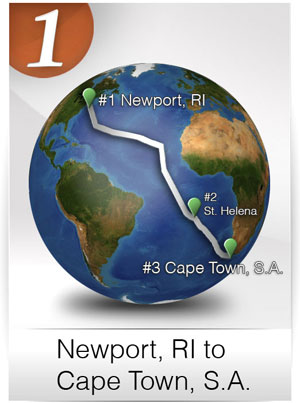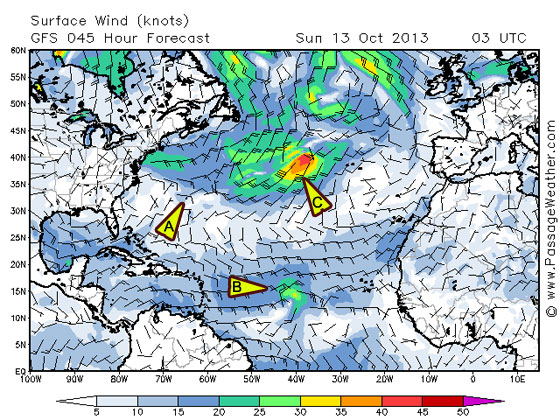 WEATHER is without question the most essential variable in our getting to and from wherever it is we want to go on the water. High pressure systems, low pressure systems, troughs, omega blocks … all these terms refer to things that remind me of those blobs in a Lava Lamp! There are all around us these great bubbles of air masses that move about, pushing and blocking or sometimes combining to create bigger blobs that move their way through and around the Earth’s atmosphere. Certain areas of the globe constitute more definable weather regions where scientific measuring instruments are used to predict – with some fair degree of accuracy, how different winds and weather systems will behave over time. Still, in spite of constantly improving tools for data gathering, it remains a fairly complicated and uncertain science.
WEATHER is without question the most essential variable in our getting to and from wherever it is we want to go on the water. High pressure systems, low pressure systems, troughs, omega blocks … all these terms refer to things that remind me of those blobs in a Lava Lamp! There are all around us these great bubbles of air masses that move about, pushing and blocking or sometimes combining to create bigger blobs that move their way through and around the Earth’s atmosphere. Certain areas of the globe constitute more definable weather regions where scientific measuring instruments are used to predict – with some fair degree of accuracy, how different winds and weather systems will behave over time. Still, in spite of constantly improving tools for data gathering, it remains a fairly complicated and uncertain science.
On an expedition such as ours, where we’re traveling through so many different weather regions, a lot of time is spent planning a route that avoids the worst of the weather. In a perfect world, we would love to leave harbor in fair weather with a following breeze (a breeze that’s from behind and not on the face) and route ourselves to avoid areas of bad weather and no wind. Racing sailors don’t get the luxury of choosing when to depart – races start and are sailed regardless of the weather that’s encountered along the course —adding an edgy and challenging element to the sport.
This part of the Atlantic Ocean where we are now, is a very complicated weather region and especially at this time of the year … with the Northern Atlantic entering winter while further south, hurricanes are being generated off the African coast. As the North Atlantic edges into the fall and winter season, the weather systems move from North America towards Europe. Then, south of us here in Bermuda, is an area called the “doldrums” – more technically called an “Intertropical Convergence Zone,” where there is little or no wind. Farther south of that, the trade winds blow from Europe and Africa to the west towards North America, and occasionally bring with them tropical waves, which can build into tropical depressions that can further intensify into hurricanes. Hurricanes, as we well know, can take on a life of their own sometimes, spinning around before being swept up into another increasing pressure system … or not finding one, then dissipating altogether. While some of this is predictable, beyond five days it’s very difficult to forecast specifics with any accuracy.
My trip to South Africa will take over 30 days, so making weather decisions with only a few day’s accuracy can be difficult and unsettling sometimes. But that said, this IS the conversation that sailors have always had with the sea. It is the encounter with nature as she is, and thus something you must adapt to if you are going to venture out into open water.
 This time of year is not the easiest time of year to be making this passage into the South Atlantic, but if done with some caution and an eye (and ear) open to sound advice, a safe passage can be designed. Personally, there is this strange adjustment that I need to make to change my land-based and goal-orientated state of mind to the more flexible and patient approach better suited to life on the water. As I write this, my mind is focused on Leg #1 of the circumnavigation and on trying to get to St. Helena Island and then onto Cape Town, South Africa before Thanksgiving … but here I am in Bermuda, unexpectedly now for four or five days.
This time of year is not the easiest time of year to be making this passage into the South Atlantic, but if done with some caution and an eye (and ear) open to sound advice, a safe passage can be designed. Personally, there is this strange adjustment that I need to make to change my land-based and goal-orientated state of mind to the more flexible and patient approach better suited to life on the water. As I write this, my mind is focused on Leg #1 of the circumnavigation and on trying to get to St. Helena Island and then onto Cape Town, South Africa before Thanksgiving … but here I am in Bermuda, unexpectedly now for four or five days.
So, flexibility and patience require me to weigh all alternatives, one of which may be skipping St. Helena Island altogether and sailing directly to South Africa. The reason for this is that the winds this time of year are coming directly from St. Helena, which would require a lengthy, upwind sail which isn’t ideal or comfortable in a vessel like Bodacious Dream. A more traditional approach would be to sail across the trade winds on a more comfortable southerly angle until you get below the winds from St. Helena Island and there pick up the prevailing winds that blow from the west and towards Cape Town.
My own basic knowledge of weather was formed in predicting the strength of storms and winds in the Great Lakes region, but when considering more complicated sailing regions around the world, I need more experienced help. I use a service called Commanders Weather, to help me predict and plan my routing. Presently, we are looking at a nice weather window for leaving Bermuda on Friday or Saturday, but then after a couple of days, the winds are expected to diminish, which may well leave me sailing slowly and somewhat vulnerable to a couple of tropical waves that may (or may not) develop into depressions that might conceivably strengthen into hurricanes. So for the moment, I am waiting to get the most current weather analyses, so I can feel confident that I am making the soundest decision I can.
I’ve included a few screenshots here from another site called PassageWeather.com that show some of the options I am considering.
Let me TRY and explain what you’re seeing here. Triangle A is Bermuda with light winds engulfing it. Triangle B shows the development of the tropical wave in the band of wind to the south, which may or may not grow in intensity. Triangle C is the circle with darker green, yellow and orange that shows winds that have already intensified.
So, bottom-line here, what these shots indicate is that the best route with the winds behind us, would be to head down along the Brazilian coast and then swing east under the empty area keeping ourselves aligned with the winds pointing in the direction of Cape Town.
I know this may be new stuff for many of you … but I include it (and in some detail) because it is such a big part of what makes this whole expedition so amazing. As navigating sailors we must align ourselves with these dynamic current and climate shifts, as they are the forces that propel us forward … as well as what constantly renews and refreshes life on our planet. These seasonal and cyclical changes bring renewal to Earth’s bio-systems, affecting all various levels of the ocean’s food chain, which thus support the migration patterns of whales, birds and other marine life.
While we humans may have a say in deciding just when we weigh anchor, once we do, we are as much a part of that migratory process as the rest of nature. In the world, and especially on the water, everything is a part of some larger flow, and we are no exception.
– Dave and Bodacious Dream



